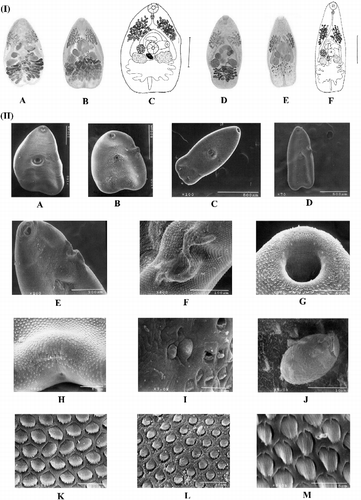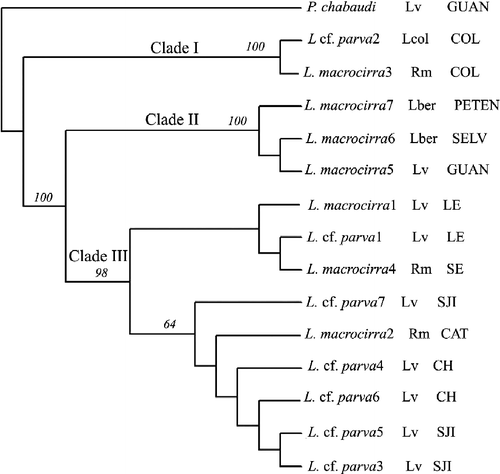Figures & data
Table I. Host, locality, geographical coordinates, and GenBank accession numbers for cox1 and ITS2 sequences of analyzed samples.
Figure 1. Morphological comparison of two nominal species of identified Langeronia and SEM photomicrographs. (I) General morphology: L. macrocirra (A–C) and L. cf. parva (D–F). (A) Holotype, Lithobates sp. (locality unknown, CNHE 13885), Mexico. (B) R. marina Lago de Catemaco, Veracruz (CNHE 4875). (C) R. marina, Lago de Catemaco, Veracruz (CNHE 4875). (D) Paratype, Lithobates pipiens, Alburg, Vermont, USA (USNPC 70558) and L. vaillanti, Laguna Escondida, Veracruz (CNHE 4874). (E) L. vaillanti, Laguna Escondida, Veracruz (CNHE 4874). (F) L. vaillanti, Laguna Escondida, Veracruz (CNHE 4874). Reference bar: C = 0.5 mm and F = 0.3 mm. (II) SEM photomicrographs: L. macrocirra from Lago de Catemaco, Veracruz, R. marina: (A, B, F–I, K, and L). L. cf. parva from Laguna Escondida, Veracruz, L. vaillanti (C–E, and J).Whole worm without tuck (A and C) and with tuck (B and E). Details of the tuck (E and F). Ciliated dome-shaped papillae (type I) on ventral surface anterior part of the oral sucker (G). Excretory pore (H). Small non-ciliated dome-shaped papillae (type II) close to a papillae type I on ventral surface around the acetabulum (I). Egg rough elliptical and operculate (J). Tegumental spines allocated near to the acetabulum (K). Spines allocated near to the posterior end (L). Small papillae ciliated among spines (M).

Table II. Pairwise genetic distances (%) among cox1 sequences of analyzed specimens.
Figure 2. Strict consensus tree of seven equally parsimonious trees obtained from maximum parsimony analysis using partial cox1 gene sequences. Bootstrap percentages are shown above internal nodes. Geographical origin is designated as follows: Colima: Coquimatlán (COL); Veracruz: Lago de Catemaco (CAT), Laguna Escondida (LE), Salto de Eyipantla (SE); Oaxaca: San José Independencia (SJI), Chapultepec (CH); Costa Rica: La Selva Biological Station (SELV), Rio Pizote, Guanacaste (GUAN); Guatemala: El Petén (PETEN). Hosts: L. vaillanti (Lv), L. berlandieri (Lber), Lithobates sp. Colima (Lcol), R. marina (Rm).
